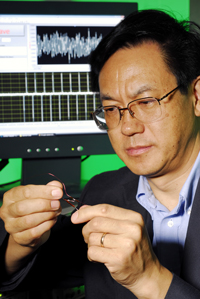- News
12 December 2011
MRS Medal for Georgia Tech ZnO nanostructure researcher Zhong Lin Wang
 At the 2011 MRS Fall Meeting in Boston, MA, USA (28 November – 2 December), one of the two MRS Medals was awarded to Zhong Lin Wang, a Regent’s professor at the Georgia Institute of Technology in Atlanta, GA, USA. The medal’s commendation notes his “seminal contributions in the discovery, controlled synthesis, and fundamental understanding of zinc oxide nanowires and nanobelts, and the design and fabrication of novel, nanowire-based nanosensors, piezotronic devices and nanogenerators for energy harvesting.”
At the 2011 MRS Fall Meeting in Boston, MA, USA (28 November – 2 December), one of the two MRS Medals was awarded to Zhong Lin Wang, a Regent’s professor at the Georgia Institute of Technology in Atlanta, GA, USA. The medal’s commendation notes his “seminal contributions in the discovery, controlled synthesis, and fundamental understanding of zinc oxide nanowires and nanobelts, and the design and fabrication of novel, nanowire-based nanosensors, piezotronic devices and nanogenerators for energy harvesting.”
Wang joined Georgia Tech in 1995, after earning his Ph.D. at Arizona State University and working for Oak Ridge National Laboratory and the National Institute of Standards and Technology (NIST). His first interest was electron microscopy.
Picture: Zhong Lin Wang displays flexible charge pumps that are able to produce alternating current through the stretching and relaxing of ZnO wires.
He got his first major international attention from research on carbon nanotubes. Collaboration with Georgia Tech physicist Walt de Heer – now known for his work with epitaxial graphene – produced a 1996 paper on nanotube properties that included a microscope image of a carbon particle on the end of a nanotube. Analyzing the nanotube’s vibration allowed the researchers to determine the approximate mass of the particle, and their device become known as a ‘nanobalance’.
But, in search of a research area with more opportunity, Wang returned to his undergraduate roots in oxide materials, in particular zinc oxide. Georgia Tech says that Wang has since almost single-handedly launched a new field of research that takes advantage of the unique properties of ZnO nanostructures.
“Zinc oxide has a lot of advantages because of its semiconducting, piezoelectric, optical and other properties for sensors, transducers, energy applications and other uses,” Wang notes. He began work on the material in 1999 and quickly produced significant results, including the development of ‘nanobelts’ (reported in the journal Science in 2001). Details of the structures and their synthesis attracted other researchers, and the paper has now been cited more than 3500 times.
The nanobelt paper was followed by years of work investigating the properties and synthesis of ZnO structures. Perhaps the most significant advance was the ability to grow aligned arrays of ZnO nanowires, leading directly to the development of nanogenerators, which harvest mechanical energy from the environment (taking advantage of the piezoelectric properties of ZnO nanowires to produce electrical current). Reported in April 2006 in the journal Science, nanogenerators drew international attention to Georgia Tech and rapidly led to a series of improvements that opened up new ways of powering nanometer-scale devices for building self-powered nanotechnology. Starting with output that could barely be measured in 2006, Wang’s research team has steadily improved the devices until arrays of connected nanogenerators can now produce as much as 30V. The generators now produce enough power to operate conventional electronic components such as LED displays.
In the last few years, Wang has used the piezoelectric properties of the nanostructures to control charge transport in new forms of ‘piezotronic’ electronic devices (e.g. logic gates and memory), providing an alternative to traditional CMOS technology, as well as light-emitting diodes enhanced with an effect that he has termed ‘piezo-phototronics’ (to describe techniques for controlling electro-optical processes in devices). Multiple devices have been combined into self-powered sensing systems that not only detect harmful materials, but also alert authorities wirelessly. Wang has also built systems that combine different kinds of power harvesting, such as nanogenerators and photovoltaic cells, and developed a hybrid cell for the first time.
In his 16-year career at Georgia Tech, Wang has produced 28 patent applications, along with another dozen invention disclosures. He has formed a startup company to commercialize the technology, and published more than 20 articles in Science and Nature journals. Overall, he estimates his research team has produced more than 700 publications that have been cited 45,000 times (with an h index of 103).
Wang leads a large research group composed of post-doctoral fellows, graduate students and undergraduate students. From his laboratory have come seven graduates who now hold assistant professor positions at US institutions, plus more than 50 working at universities in China or Taiwan.
